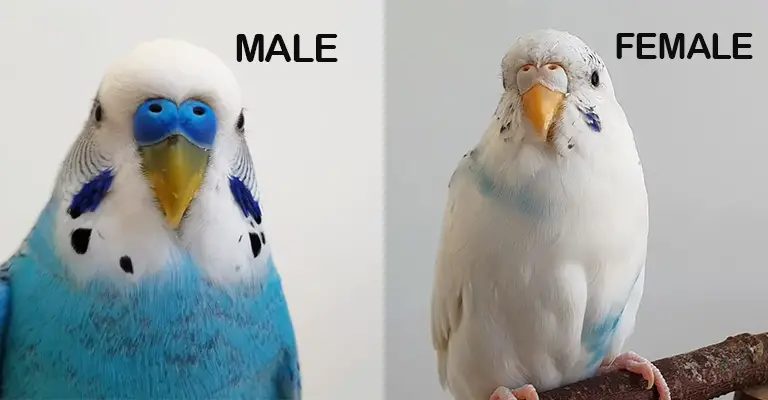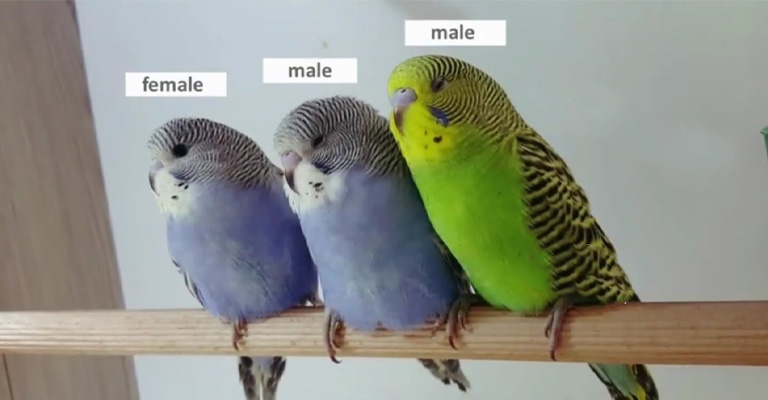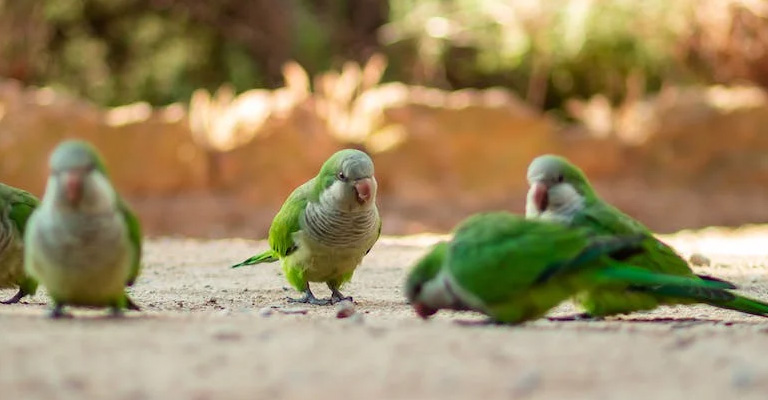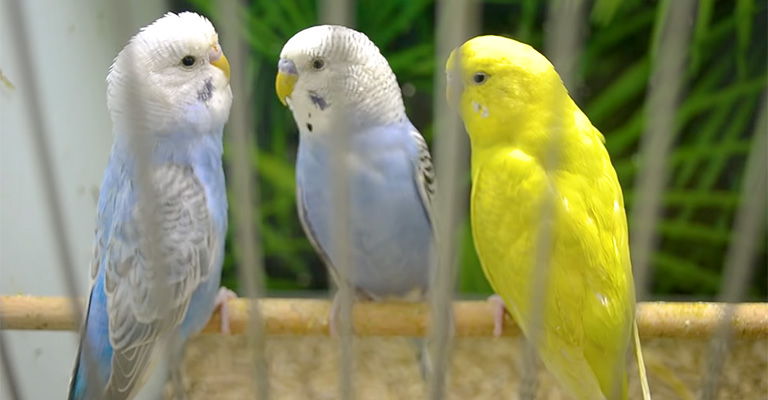Parakeets, also known as budgerigars, are small and colorful birds that make popular pets. If you own a pair of parakeets, you may be curious about their genders.
Determining the sex of these birds can be challenging, especially if they haven’t been bred or don’t display obvious physical differences.
However, with a little observation and some knowledge about parakeet characteristics, you can increase your chances of correctly identifying the sex of your feathered friends. So, let’s explore how can I figure out the sex of my parakeets.

How Can I Figure Out the Sex of My Parakeets?
Determining the gender of parakeets can be challenging, as different species may exhibit various physical characteristics or behaviors. However, here are some general methods that may help you determine the gender of parakeets:
Size and Body Structure
In some species, males tend to be larger in size compared to females. They may have a broader chest, a larger head, or longer tail feathers. However, this method can be subjective and may not be applicable to all species.
Plumage Differences
Look for any differences in the coloration or patterns of the feathers between males and females. In some parakeet species, males may have brighter or more vibrant plumage, while females exhibit duller or more subdued colors.
Additionally, some species may display specific markings or patterns on certain feathers that are exclusive to one gender.
Head and Facial Features
Pay attention to the head and facial features of the parakeets. Males may have more prominent or larger ceres, facial patches, or distinctively shaped beaks compared to females.
Females, on the other hand, may have smaller or less prominent features in these areas.
Vocalizations and Behaviors
As with budgies, some parakeet species may exhibit gender-specific vocalizations or behaviors. Males may engage in more elaborate or vocal courtship displays, such as singing or dancing, to attract females.
Females may display nesting behaviors or exhibit specific calls associated with breeding.
Age
Parakeets generally reach sexual maturity around six months of age. Before this point, it can be difficult to determine their sex accurately. Keep in mind that some individual birds may mature earlier or later, so age alone is not always a foolproof method.
Cere
The cere is the fleshy area located just above the beak, where the nostrils are found. In adult parakeets, the cere can provide some clues about their sex. In males, the cere typically appears bluish or purplish, while in females, it tends to be brown or beige.
However, it’s essential to note that this method is not always accurate, as young males and certain mutations can have cere colors that resemble those of females.
Behavior
While not a definitive indicator, certain behaviors may suggest the sex of your parakeets. Males are generally more vocal and prone to mimic sounds or talk. They may also engage in head-bobbing, singing, or other attention-seeking behaviors to attract a mate.
Females, on the other hand, tend to be quieter and less inclined to mimic sounds.
Courtship Displays
When parakeets are of breeding age and are housed together, their courtship behaviors can provide insights into their gender.
Males often engage in specific displays, such as fluffing up their feathers, regurgitating food to offer to the female, or performing a “bowing” motion to woo their potential mate.
Nesting Behavior
If you notice your parakeets showing nesting behavior, such as exploring potential nesting sites or gathering materials like twigs and feathers, it’s more likely that you have a female.
Females are primarily responsible for building nests and preparing for egg-laying.
DNA Testing
If you want to be absolutely sure about the sex of your parakeets, a DNA test is the most accurate method. It involves sending a small blood sample or a feather follicle to a specialized laboratory for analysis. DNA testing is especially useful when dealing with young or visually ambiguous birds.
Remember, it’s important to respect your parakeets’ privacy and natural behavior. Avoid disturbing them excessively, as this may cause stress and negatively impact their well-being.
If you’re unsure about their sex, consult a qualified avian veterinarian or an experienced breeder who can provide further guidance.
How to Tell the Gender of Various Parakeet Species?

Determining the gender of various parakeet species can be challenging, as different species may have unique characteristics that indicate their sex. Here are some general guidelines for determining the gender of popular parakeet species:
Cockatiels
- Plumage Differences: In mature cockatiels, males often have bright, vibrant plumage, particularly on their faces, with bright yellow or white crests. Females, on the other hand, usually have duller plumage, often with gray or dull yellow crests.
- Facial Markings: Males typically have bright orange cheek patches, while females may have paler or less distinct cheek patches.
- Vocalizations: Male cockatiels are known for their loud and melodious songs or whistles, whereas females are generally quieter.
Lovebirds
- Size and Behavior: In some lovebird species, such as the Fischer’s Lovebird, males tend to be slightly larger and more active than females.
- Head Shape: Males may have broader or larger heads compared to females.
- Beak Color: In some lovebird species, males have brighter or more intense beak colors compared to females.
Lineolated Parakeets (Linnies)

- Plumage Differences: In Linnies, males often have brighter or more vibrant plumage, particularly on their foreheads and chests, while females may exhibit duller colors.
- Cere Color: Males typically have a bluish or purplish cere, while females tend to have a beige or brown cere.
Bourke’s Parakeets
- Plumage Differences: In Bourke’s parakeets, males generally have brighter or richer colors, especially on their chests, while females exhibit paler or more muted colors.
- Behavior: Males may be more vocal and engage in courtship behaviors, such as bobbing their heads or wing flapping.
Ring-necked Parakeets
- Plumage Differences: In some subspecies of Ring-necked parakeets, males often have brighter and more intense plumage colors compared to females, particularly on their neck rings.
- Ring Color: Males may have a thicker or more pronounced neck ring, while females may have a thinner or less distinct ring.
It’s important to note that these guidelines may not apply to every individual bird within a species, as there can be variations in plumage and physical characteristics. Additionally, some parakeet species may require more specialized knowledge or DNA testing for accurate gender determination.
If you’re uncertain about the gender of your parakeet, consulting an experienced avian veterinarian or an experienced breeder who is knowledgeable about the specific species can provide more accurate guidance.
Why Does the Gender of Your Parakeet Matter?

The gender of a parakeet may or may not matter depending on your specific situation and objectives. Here are a few factors to consider:
Breeding
If you are interested in breeding parakeets, having a male and a female is necessary for successful reproduction. Understanding the gender of your parakeets becomes important to ensure you have a suitable pair for breeding purposes.
Companionship
For many parakeet owners, the gender of their birds may not be a significant factor when it comes to companionship. Parakeets can form strong bonds and develop close relationships regardless of their gender.
A single parakeet can be a wonderful pet, providing companionship and entertainment. However, if you plan to keep multiple parakeets, the compatibility of their personalities and temperaments may be more important than their gender.
Vocalizations and Behavior
It’s worth noting that male and female parakeets can exhibit slightly different vocalizations and behaviors. Males may be more inclined to sing, mimic sounds, or engage in attention-seeking behaviors.
Females may be quieter and exhibit nesting behaviors. These differences can add some variation to your parakeet’s behavior and interactions, but they do not significantly impact their ability to be loving and enjoyable pets.
Color Preferences
Some individuals may have a preference for certain colors or patterns in parakeets. If you have a specific color preference, knowing the gender can help you select a parakeet with the desired coloration. However, it’s essential to prioritize the well-being and care of the bird over specific aesthetic preferences.
In general, while the gender of a parakeet may have some relevance depending on your goals or preferences, it does not inherently determine the quality of their companionship or the joy they can bring as pets.
The most crucial aspects of parakeet ownership are providing proper care, attention, and a nurturing environment to ensure their well-being and happiness, regardless of their gender.
FAQs
Yes, the cere color of parakeets can change as they age. In young parakeets, both males and females have cere colors that are more similar, usually appearing pink or purplish.
As they mature, the cere color of males typically changes to a bluish or purplish hue, while females’ cere color tends to become brown or beige.
While behavior can provide some clues about a parakeet’s sex, it is not a definitive indicator. Male parakeets tend to be more vocal, mimicking sounds and engaging in attention-seeking behaviors like head-bobbing and singing.
Females, on the other hand, are generally quieter and less prone to mimicry.
Parakeets typically reach sexual maturity around six months of age. However, this can vary between individuals, and some birds may mature earlier or later. It’s important to note that even if a parakeet has reached sexual maturity, determining its sex visually can still be challenging.
Parakeets are social birds and can form strong bonds with their flock mates, regardless of their sex. However, when it comes to mating and reproduction, a male and a female pair is required.
Same-sex pairs may engage in bonding behaviors, such as preening and nesting, but they won’t be able to reproduce naturally.
Apart from observing behavior and cere color, as mentioned earlier, DNA testing is the most accurate method to determine the sex of parakeets. A small blood sample or a feather follicle is sent to a specialized laboratory for analysis.
Final Words
Now you know How can I figure out the sex of my parakeets. In conclusion, determining the sex of your parakeets can be challenging, particularly when they are young or lack distinct physical characteristics.
By observing their behavior, noting the color of their cere, and considering other factors like age and courtship displays, you can make an educated guess about their gender.
For complete accuracy, consider opting for DNA testing. Regardless of their sex, providing your parakeets with a loving and caring environment is crucial for their overall happiness and well-being.